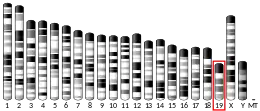AP5B1
AP-5 complex subunit beta (AP5B1) is a protein that in humans is encoded by the AP5B1 gene.[5]
| AP5B1 | |||||||||||||||||||||||||||||||||||||||||||||||||||
|---|---|---|---|---|---|---|---|---|---|---|---|---|---|---|---|---|---|---|---|---|---|---|---|---|---|---|---|---|---|---|---|---|---|---|---|---|---|---|---|---|---|---|---|---|---|---|---|---|---|---|---|
| Identifiers | |||||||||||||||||||||||||||||||||||||||||||||||||||
| Aliases | AP5B1, AP-5, PP1030, adaptor related protein complex 5 beta 1 subunit, adaptor related protein complex 5 subunit beta 1 | ||||||||||||||||||||||||||||||||||||||||||||||||||
| External IDs | OMIM: 614367 MGI: 2685808 HomoloGene: 16299 GeneCards: AP5B1 | ||||||||||||||||||||||||||||||||||||||||||||||||||
| |||||||||||||||||||||||||||||||||||||||||||||||||||
| |||||||||||||||||||||||||||||||||||||||||||||||||||
| |||||||||||||||||||||||||||||||||||||||||||||||||||
| |||||||||||||||||||||||||||||||||||||||||||||||||||
| |||||||||||||||||||||||||||||||||||||||||||||||||||
| Wikidata | |||||||||||||||||||||||||||||||||||||||||||||||||||
| |||||||||||||||||||||||||||||||||||||||||||||||||||
Function
The protein encoded by this gene is one of two large subunits of the AP5 adaptor complex.[6] Variants in this gene have not been implicated in any disease but damaging variants in AP5Z1, the gene encoding the other large subunit in this complex, are associated with SPG48, a type of hereditary spastic paraplegia.[7][8] In addition, damaging variants in the genes encoding two proteins that stably associate with the AP-5 adaptor complex are also associated with forms of hereditary spastic paraplegia - SPG11 with the disease of the same name[9] and ZFYVE26 with SPG15.[10]
GnomAD reports an observed v. expected ratio of predicted loss-of-function variants of 0.84 (0.58 - 1.24) for AP5B1.[11][12]
References
- GRCh38: Ensembl release 89: ENSG00000254470 - Ensembl, May 2017
- GRCm38: Ensembl release 89: ENSMUSG00000049562 - Ensembl, May 2017
- "Human PubMed Reference:". National Center for Biotechnology Information, U.S. National Library of Medicine.
- "Mouse PubMed Reference:". National Center for Biotechnology Information, U.S. National Library of Medicine.
- Hirst, Jennifer; Barlow, Lael D.; Francisco, Gabriel Casey; Sahlender, Daniela A.; Seaman, Matthew N. J.; Dacks, Joel B.; Robinson, Margaret S. (2011-10-11). "The fifth adaptor protein complex". PLOS Biology. 9 (10): e1001170. doi:10.1371/journal.pbio.1001170. ISSN 1545-7885. PMC 3191125. PMID 22022230.
- Hirst, Jennifer; Irving, Carol; Borner, Georg H. H. (2012-11-21). "Adaptor protein complexes AP-4 and AP-5: new players in endosomal trafficking and progressive spastic paraplegia". Traffic. 14 (2): 153–164. doi:10.1111/tra.12028. ISSN 1600-0854. PMID 23167973. S2CID 13766991. Archived from the original on 2022-02-10. Retrieved 2022-07-09.
- Słabicki, Mikołaj; Theis, Mirko; Krastev, Dragomir B.; Samsonov, Sergey; Mundwiller, Emeline; Junqueira, Magno; Paszkowski-Rogacz, Maciej; Teyra, Joan; Heninger, Anne-Kristin; Poser, Ina; Prieur, Fabienne (2010-06-29). "A genome-scale DNA repair RNAi screen identifies SPG48 as a novel gene associated with hereditary spastic paraplegia". PLOS Biology. 8 (6): e1000408. doi:10.1371/journal.pbio.1000408. ISSN 1545-7885. PMC 2893954. PMID 20613862.
- Hirst, Jennifer; Madeo, Marianna; Smets, Katrien; Edgar, James R.; Schols, Ludger; Li, Jun; Yarrow, Anna; Deconinck, Tine; Baets, Jonathan; Van Aken, Elisabeth; De Bleecker, Jan (2016-08-25). "Complicated spastic paraplegia in patients with AP5Z1 mutations (SPG48)". Neurology. Genetics. 2 (5): e98. doi:10.1212/NXG.0000000000000098. ISSN 2376-7839. PMC 5001803. PMID 27606357.
- Stevanin, Giovanni (1993), Adam, Margaret P.; Mirzaa, Ghayda M.; Pagon, Roberta A.; Wallace, Stephanie E. (eds.), "Spastic Paraplegia 11", GeneReviews®, Seattle (WA): University of Washington, Seattle, PMID 20301389, archived from the original on 2022-01-22, retrieved 2022-07-09
- Hanein, Sylvain; Martin, Elodie; Boukhris, Amir; Byrne, Paula; Goizet, Cyril; Hamri, Abdelmadjid; Benomar, Ali; Lossos, Alexander; Denora, Paola; Fernandez, José; Elleuch, Nizar (April 2008). "Identification of the SPG15 gene, encoding spastizin, as a frequent cause of complicated autosomal-recessive spastic paraplegia, including Kjellin syndrome". American Journal of Human Genetics. 82 (4): 992–1002. doi:10.1016/j.ajhg.2008.03.004. ISSN 1537-6605. PMC 2427184. PMID 18394578.
- "GnomAD".
- "Loss-of-Function Curations in gnomAD | gnomAD browser".



